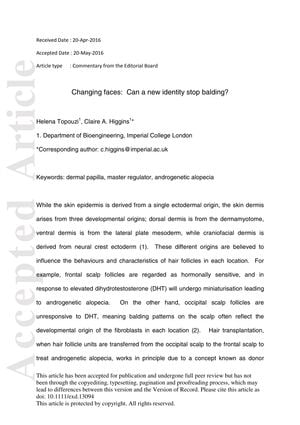Changing Faces: Can a New Identity Stop Balding?
June 2016
in “
Experimental Dermatology
”

TLDR Changing hair follicle identity could potentially reverse balding.
The commentary from the Editorial Board of Imperial College London discusses the potential of changing the identity of hair follicles to treat androgenetic alopecia, a common form of hair loss. The authors explain that hair follicles from different parts of the scalp have different developmental origins, which affects their response to dihydrotestosterone (DHT) and their susceptibility to balding. Hair transplantation works because follicles retain their original characteristics even when moved to a different location on the scalp. The article highlights a study by Kwack et al. that found differences in the expression of the Wnt receptor SFRP2 among dermal papilla cells from various scalp locations, with higher levels in beard hair and lower levels in frontal scalp hair. SFRP2 expression was positively correlated with the hair-inducing potential of papilla cells, and reducing SFRP2 expression in occipital scalp hair follicles decreased their inductivity. The authors suggest that future research should focus on identifying master regulators that control the identity of dermal papilla cells, which could lead to reprogramming a frontal scalp papilla to behave like an occipital scalp papilla, potentially reversing hair follicle miniaturization.










